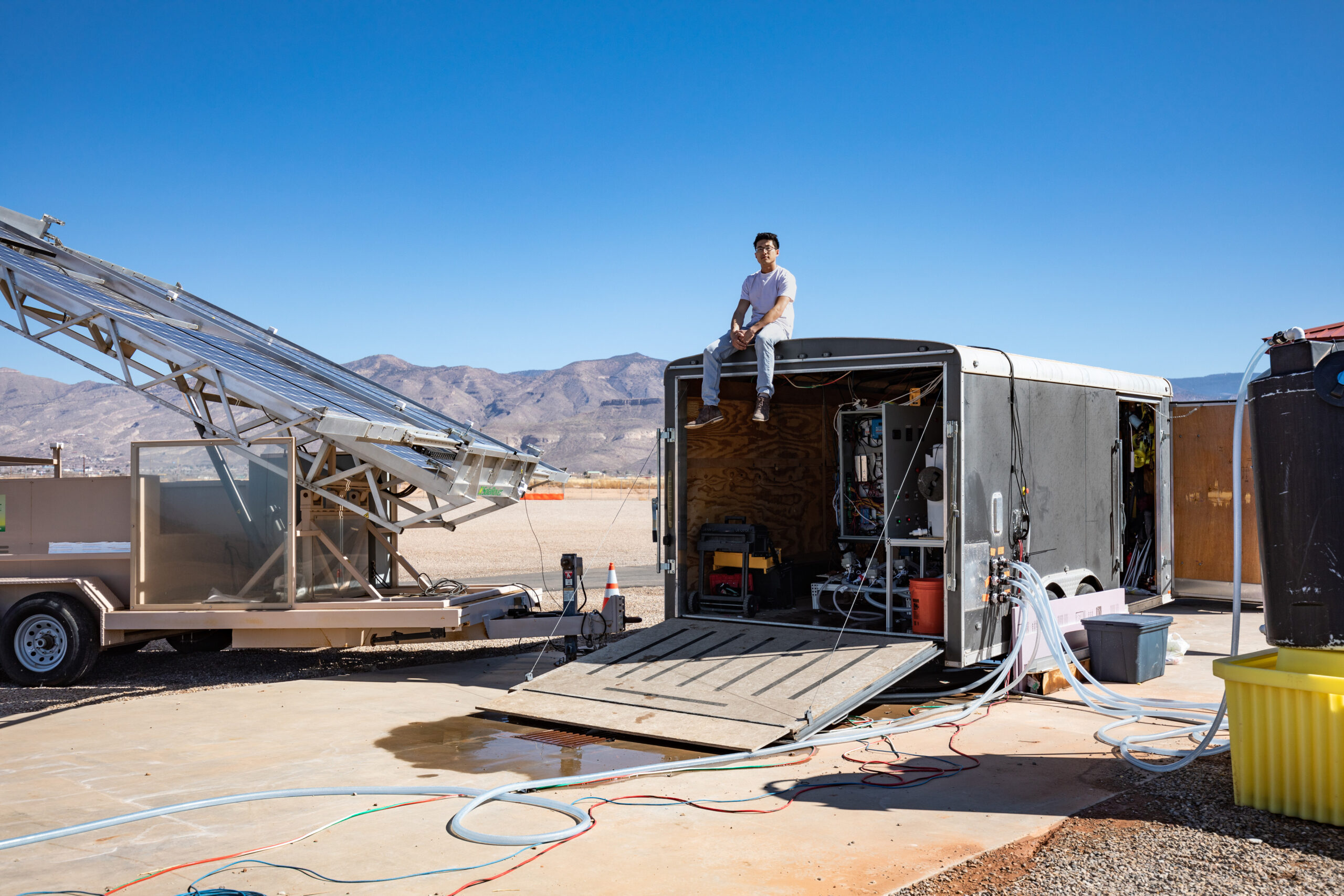Solar-powered desalination system requires no extra batteries
October 8, 2024

MIT engineers have built a new desalination system that runs with the rhythms of the sun.
The solar-powered system removes salt from water at a pace that closely follows changes in solar energy. As sunlight increases through the day, the system ramps up its desalting process and automatically adjusts to any sudden variation in sunlight, for example by dialing down in response to a passing cloud or revving up as the skies clear.
Because the system can quickly react to subtle changes in sunlight, it maximizes the utility of solar energy, producing large quantities of clean water despite variations in sunlight throughout the day. In contrast to other solar-driven desalination designs, the MIT system requires no extra batteries for energy storage, nor a supplemental power supply, such as from the grid.
The engineers tested a community-scale prototype on groundwater wells in New Mexico over six months, working in variable weather conditions and water types. The system harnessed on average over 94 percent of the electrical energy generated from the system’s solar panels to produce up to 5,000 liters of water per day despite large swings in weather and available sunlight.
“Conventional desalination technologies require steady power and need battery storage to smooth out a variable power source like solar. By continually varying power consumption in sync with the sun, our technology directly and efficiently uses solar power to make water,” says Amos Winter, the Germeshausen Professor of Mechanical Engineering and director of the K. Lisa Yang Global Engineering and Research (GEAR) Center at MIT. “Being able to make drinking water with renewables, without requiring battery storage, is a massive grand challenge. And we’ve done it.”
The system is geared toward desalinating brackish groundwater — a salty source of water that is found in underground reservoirs and is more prevalent than fresh groundwater resources. The researchers see brackish groundwater as a huge untapped source of potential drinking water, particularly as reserves of fresh water are stressed in parts of the world. They envision that the new renewable, battery-free system could provide much-needed drinking water at low costs, especially for inland communities where access to seawater and grid power are limited.
“The majority of the population actually lives far enough from the coast, that seawater desalination could never reach them. They consequently rely heavily on groundwater, especially in remote, low-income regions. And unfortunately, this groundwater is becoming more and more saline due to climate change,” says Jonathan Bessette, MIT PhD student in mechanical engineering. “This technology could bring sustainable, affordable clean water to underreached places around the world.”
The researchers report details the new system in a paper appearing today in Nature Water. The study’s co-authors are Bessette, Winter, and staff engineer Shane Pratt.
Pump and flow
The new system builds on a previous design, which Winter and his colleagues, including former MIT postdoc Wei He, reported earlier this year. That system aimed to desalinate water through “flexible batch electrodialysis.”
Electrodialysis and reverse osmosis are two of the main methods used to desalinate brackish groundwater. With reverse osmosis, pressure is used to pump salty water through a membrane and filter out salts. Electrodialysis uses an electric field to draw out salt ions as water is pumped through a stack of ion-exchange membranes.
Scientists have looked to power both methods with renewable sources. But this has been especially challenging for reverse osmosis systems, which traditionally run at a steady power level that’s incompatible with naturally variable energy sources such as the sun.
Winter, He, and their colleagues focused on electrodialysis, seeking ways to make a more flexible, “time-variant” system that would be responsive to variations in renewable, solar power.
In their previous design, the team built an electrodialysis system consisting of water pumps, an ion-exchange membrane stack, and a solar panel array. The innovation in this system was a model-based control system that used sensor readings from every part of the system to predict the optimal rate at which to pump water through the stack and the voltage that should be applied to the stack to maximize the amount of salt drawn out of the water.
When the team tested this system in the field, it was able to vary its water production with the sun’s natural variations. On average, the system directly used 77 percent of the available electrical energy produced by the solar panels, which the team estimated was 91 percent more than traditionally designed solar-powered electrodialysis systems.
Still, the researchers felt they could do better.
“We could only calculate every three minutes, and in that time, a cloud could literally come by and block the sun,” Winter says. “The system could be saying, ‘I need to run at this high power.’ But some of that power has suddenly dropped because there’s now less sunlight. So, we had to make up that power with extra batteries.”
Solar commands
In their latest work, the researchers looked to eliminate the need for batteries, by shaving the system’s response time to a fraction of a second. The new system is able to update its desalination rate, three to five times per second. The faster response time enables the system to adjust to changes in sunlight throughout the day, without having to make up any lag in power with additional power supplies.
The key to the nimbler desalting is a simpler control strategy, devised by Bessette and Pratt. The new strategy is one of “flow-commanded current control,” in which the system first senses the amount of solar power that is being produced by the system’s solar panels. If the panels are generating more power than the system is using, the controller automatically “commands” the system to dial up its pumping, pushing more water through the electrodialysis stacks. Simultaneously, the system diverts some of the additional solar power by increasing the electrical current delivered to the stack, to drive more salt out of the faster-flowing water.
“Let’s say the sun is rising every few seconds,” Winter explains. “So, three times a second, we’re looking at the solar panels and saying, ‘Oh, we have more power — let’s bump up our flow rate and current a little bit.’ When we look again and see there’s still more excess power, we’ll up it again. As we do that, we’re able to closely match our consumed power with available solar power really accurately, throughout the day. And the quicker we loop this, the less battery buffering we need.”
The engineers incorporated the new control strategy into a fully automated system that they sized to desalinate brackish groundwater at a daily volume that would be enough to supply a small community of about 3,000 people. They operated the system for six months on several wells at the Brackish Groundwater National Desalination Research Facility in Alamogordo, New Mexico. Throughout the trial, the prototype operated under a wide range of solar conditions, harnessing over 94 percent of the solar panel’s electrical energy, on average, to directly power desalination.
“Compared to how you would traditionally design a solar desal system, we cut our required battery capacity by almost 100 percent,” Winter says.
The engineers plan to further test and scale up the system in hopes of supplying larger communities, and even whole municipalities, with low-cost, fully sun-driven drinking water.
“While this is a major step forward, we’re still working diligently to continue developing lower cost, more sustainable desalination methods,” Bessette says.
“Our focus now is on testing, maximizing reliability, and building out a product line that can provide desalinated water using renewables to multiple markets around the world,” Pratt adds.
The team will be launching a company based on their technology in the coming months.
This research was supported in part by the National Science Foundation, the Julia Burke Foundation, and the MIT Morningside Academy of Design. This work was additionally supported in-kind by Veolia Water Technologies and Solutions and Xylem Goulds.
Search
RECENT PRESS RELEASES
Related Post


